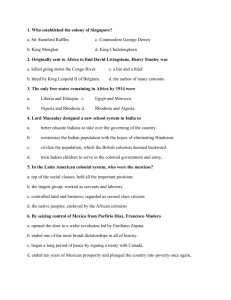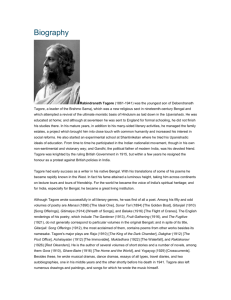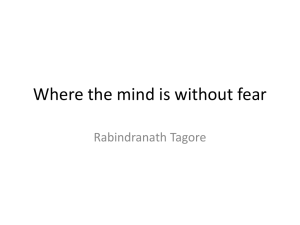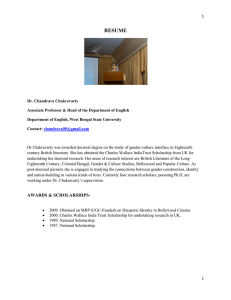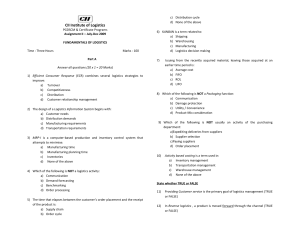Japan-Bengal 100-Year Relations.doc
advertisement
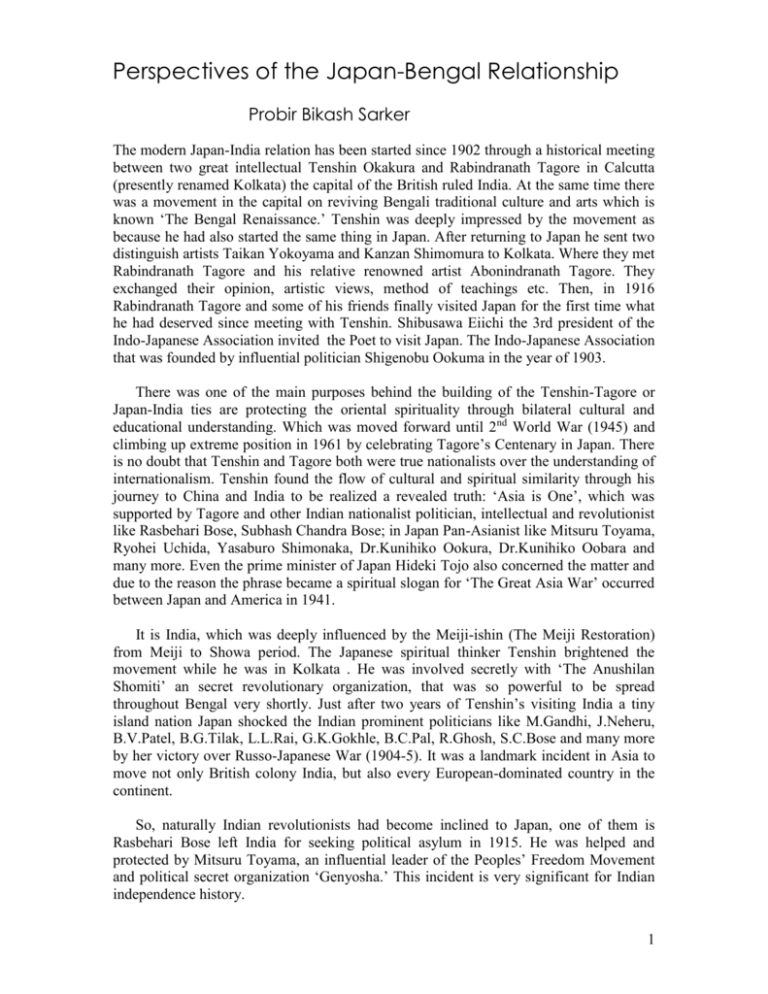
Perspectives of the Japan-Bengal Relationship Probir Bikash Sarker The modern Japan-India relation has been started since 1902 through a historical meeting between two great intellectual Tenshin Okakura and Rabindranath Tagore in Calcutta (presently renamed Kolkata) the capital of the British ruled India. At the same time there was a movement in the capital on reviving Bengali traditional culture and arts which is known ‘The Bengal Renaissance.’ Tenshin was deeply impressed by the movement as because he had also started the same thing in Japan. After returning to Japan he sent two distinguish artists Taikan Yokoyama and Kanzan Shimomura to Kolkata. Where they met Rabindranath Tagore and his relative renowned artist Abonindranath Tagore. They exchanged their opinion, artistic views, method of teachings etc. Then, in 1916 Rabindranath Tagore and some of his friends finally visited Japan for the first time what he had deserved since meeting with Tenshin. Shibusawa Eiichi the 3rd president of the Indo-Japanese Association invited the Poet to visit Japan. The Indo-Japanese Association that was founded by influential politician Shigenobu Ookuma in the year of 1903. There was one of the main purposes behind the building of the Tenshin-Tagore or Japan-India ties are protecting the oriental spirituality through bilateral cultural and educational understanding. Which was moved forward until 2nd World War (1945) and climbing up extreme position in 1961 by celebrating Tagore’s Centenary in Japan. There is no doubt that Tenshin and Tagore both were true nationalists over the understanding of internationalism. Tenshin found the flow of cultural and spiritual similarity through his journey to China and India to be realized a revealed truth: ‘Asia is One’, which was supported by Tagore and other Indian nationalist politician, intellectual and revolutionist like Rasbehari Bose, Subhash Chandra Bose; in Japan Pan-Asianist like Mitsuru Toyama, Ryohei Uchida, Yasaburo Shimonaka, Dr.Kunihiko Ookura, Dr.Kunihiko Oobara and many more. Even the prime minister of Japan Hideki Tojo also concerned the matter and due to the reason the phrase became a spiritual slogan for ‘The Great Asia War’ occurred between Japan and America in 1941. It is India, which was deeply influenced by the Meiji-ishin (The Meiji Restoration) from Meiji to Showa period. The Japanese spiritual thinker Tenshin brightened the movement while he was in Kolkata . He was involved secretly with ‘The Anushilan Shomiti’ an secret revolutionary organization, that was so powerful to be spread throughout Bengal very shortly. Just after two years of Tenshin’s visiting India a tiny island nation Japan shocked the Indian prominent politicians like M.Gandhi, J.Neheru, B.V.Patel, B.G.Tilak, L.L.Rai, G.K.Gokhle, B.C.Pal, R.Ghosh, S.C.Bose and many more by her victory over Russo-Japanese War (1904-5). It was a landmark incident in Asia to move not only British colony India, but also every European-dominated country in the continent. So, naturally Indian revolutionists had become inclined to Japan, one of them is Rasbehari Bose left India for seeking political asylum in 1915. He was helped and protected by Mitsuru Toyama, an influential leader of the Peoples’ Freedom Movement and political secret organization ‘Genyosha.’ This incident is very significant for Indian independence history. 1 If Rasbehari Bose did not come to Japan what would have happened in Indian national movement, it is now beyond of imagine. He spent almost his life in Japan and other Asian countries to collect money, buying arms, organizing secret movements in motherland, forming INA (Indian National Army) and finally calling Subhash Chandra Bose to Japan exiled in Germany for taking the leadership of INA. These great activities of Behari Bose had been completely done by his spiritual efforts with support of Mitsuru Toyama, Herambolal Gupta, Aizo and Kokko Soma (The owners of famous ‘Nakamuraya’ of Shinjuku district in Tokyo, also they were his Father and Mother-inLaw); A.M.Nair, Ryohei Uchida, Shumei Ookawa, Toten Miyazaki, Dr.Terao Touru, Masaaki Tanaka like many others those were politically active at the time. He had given the title Netaji (Leader) to Subhash Chandra Bose during the congress of INA in Singapore in 1942. Netaji convinced Prime Minister Tojo and other government leaders to help India getting Independence from British rule. With collaboration of INA Japanese solders fought for 3 years but did not achieve the goal; Japan defeated to America. But the people of India were still in fighting against the British government for freeing their motherland. After defeating of Imphal operation Nataji has gone into hiding; as a result government became feared of him. Gradually British rulers threatened under collapse of mounting non-cooperation movements all over the India, finally the British Imperial Rulers had to free India from their 200 year-old colonial oppression. It is needless to say that on sacrifice of Japanese people and her government India got its long deserved independence in 1947. On the other hand, after the war, another Indian genius Justice Dr.Radhabinod Pal, who was actually born in the then East Bengal presently Bangladesh, probated as one of the Judge of International Military Tribunal for the Far East (Tokyo Tribunal) by Allied Powers. Dr.Pal as a true nationalist was moved deeply by Japanese victory over RussoJapanese War in Meiji period, showed his braveness by given a dissent judgement in the trial. He found no international law in the court to be considered for verdict of accused criminals as guilty. Its not a true and reasonable trial but only a ‘Victor’s Justice’ to fulfill their desire for vegeance, he argued. Even he raised his voice against America’s deeds in Hiroshima and Nagasaki during the war. If Japanese Imperial soulders are guilty for killing innocent people in Manchuria, China, why not Americans? They are also bear the same responsibilty of killing thousends of innocent people with two Atom Bombs! It was the notorious crimes comitted by America that can be compared to German Nazi did in Europe. So it was very much difficult for him to deliver a judgement against the Japanese war criminals because he was such a man never enslaved his head to any offence in his life, so he decleared every war criminals accused of. He became famous for his verdict not only in Japan but all over the world. In 1952 he visited Japan for the 2nd time presiding at a world peace conference held in Hiroshima with his friend Shimonaka Yasaburo, President of Heibonsha Publisher, also Chairman of Japan World Fedaration Movement. Due to friendship with Shimonaka he became renownd world peace activist in India and Japan for the rest of his life. 2 He received the First Order of the Sacred Treasure from the hand of Emperor of Japan in 1966 for contribution to building the Japan-India relationship. According to his accounts he loved Japan and Japanese people very much. For paying honour to his memories ‘Pal-Shimonaka Memorial Meseum’ had been built in Hakone, Kanagawa prefecture in 1974. There are two monuments of Radhabonod Pal built recently one in Kyoto another in Yasukuni Shrine compound, in Kudanshita, Tokyo, proving how Japanese people are respecting him! Being a citizen of Bangladesh we are very proud of them as because they had laid foundation of Japan-Bengal relationship. There are lot of events enriched the history of the relations over the years. 05.09.2007 Tokyo.Japan Probir Bikash Sarker, Poet, Writer, Researcher also Editor of Manchitro magazine ProbirSarker@manchitro.net probirbikashsarker@gmail.com 3

